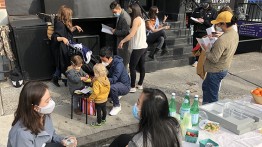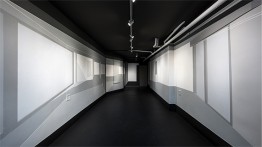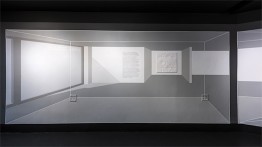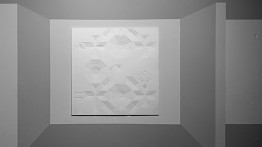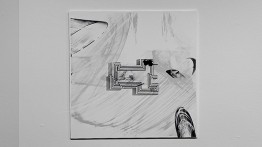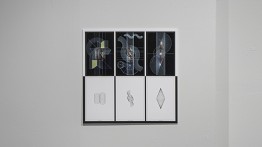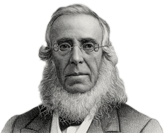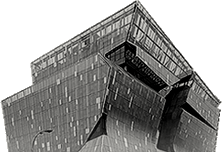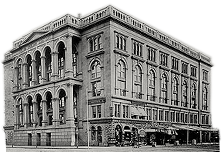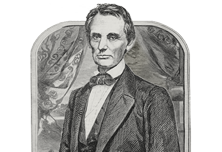Archlog
Linee Occulte: Drawing Architecture
POSTED ON: April 23, 2021
Citygroup is far from a white cube gallery. Studio Ames’ curatorial approach to the exhibition “Linee Occulte: Drawing Architecture,” highlights this fact while marking its own territory in such a way as to make visible the undercurrents for which the exhibition space formed as a response. As presented on their website, Citygroup was “formed to challenge the structural and cultural forces that shape the normative practices of architecture. […] We are unwilling to defer to the status quo of capitalist political economy and believe we must interrogate the conditions that subjugate, alienate, and appropriate architects, architecture, and inhabitants of architecture.” Not to bank on the intention of the gallery’s name as a phonetic riff, but the play on words is helpful in understanding the meaning spaces can inflect to encompassing structures and forces - such as finance, or a pandemic. Studio Ames' exhibition design and curation deploys Trompe l’oeil throughout the space as such an inflection that demarcates a space within a space and continues this logic so as to involve each drawing in a dialogue of hidden, yet visible, lines.
As explained in the curatorial statement by Studio Ames:
“In Book II on perspective, Sebastiano Serlio referred to an “unthought known” in architectural production. He referred to certain lines as: “linee occulte,” hidden lines. These hidden lines are akin to construction lines in architectural drafting, the lines necessary to conceive of the final form. Serlio describes the process of drawing forms in perspective. Unlike Alberti, he accompanies his text with drawing examples, and from one drawing to the next, certain lines appear and disappear. The ones that disappear are presumably not necessary in communicating the next step and they become a kind of lost history to drawing making. In a time when we are contending with many shared and lost histories, what importance do the lines of the past, hidden out of view, have on our process? This is the question that Linee Occulte: Drawing Architecture asks participants and viewers to consider.”
Presenting drawings within the context formed by their common theme and exhibition design, "Linee Occulte: Drawing Architecture" gives us the opportunity to see the work of Daisy Ames, Iman Fayyad, Lindsay Harkema, Kevin Hirth, Alfie Koetter, Stephanie Lin, Melissa Shin, Lindsey Wikstrom, and Mersiha Veledar as a collaborative construction.
When asked about her take on the exhibition, Stephanie Lin observed that “Linee Occulte asks us to refocus our attention to the elements, processes, forms, and structures that are underperceived, as an architectural and social agenda that are one in the same. In its exhibition design by Studio Ames, uncovering these relationships between the visible and the suppressed is meaningfully rendered through overlaid perspectives that are both continuous and multiple across the gallery space.” One may notice in Lin’s response a hint of creative tension between the “visible and the suppressed” or, likewise with Mersiha Veledar, as she adds in agreement that “[t]he unique concepts (and methods of representation) by each participant emerge within the limits of individual square tablets and amidst the matrix of precise lines Daisy carefully maps out on the surface of the walls, revealing once again the hidden in-situ context of the space beyond.” These emergent creative tensions perform a conceptual and perceptual push-and-pull between say, formal elements such as lines and proprioception —think social distancing— or between what one sees and knows. That this effect is part and parcel of the construction of a drawing, or the atmosphere and meaning of a social space is one of the many joys, along with the unique creative accomplishments by each participant, that this exhibition offers.
Tags: Mauricio Higuera, Daisy Ames, Mersiha Veledar, Stephanie Lin
Exhibition Event — Lebbeus Woods: Zagreb Free Zone Revisited
POSTED ON: April 9, 2021
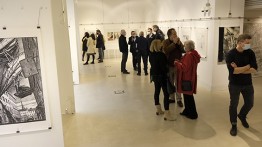
On April 13, at 12 pm EDT (6 pm CET) the Oris House of Architecture will broadcast an online opening event for its current exhibition Lebbeus Woods: Zagreb Free Zone Revisited. This exhibition recreates Zagreb Free Zone—a show originally held at the Zagreb Museum of Arts and Crafts (MUO) in 1991 by former School of Architecture faculty member Lebbeus Woods (1940 – 2012).
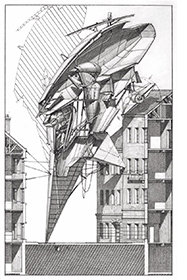
Woods taught at The Cooper Union for 25 years, and his commitment to educating architects is extensively documented in the School of Architecture’s Student Work Collection database. The School is also working closely with the Estate of Lebbeus Woods to finalize a donation of his pedagogical records to the Architecture Archive. These records, which document his design studios and seminars at The Cooper Union, will be available for educational and research use.
Lebbeus Woods: Zagreb Free Zone Revisited presents the same set of large prints shown 30 years ago at MUO. As a companion to the exhibition, an extensive monograph traces Woods’ subsequent work on the project, including original drawings, notebooks, models, and documents related to the planned construction of a Freespace structure in Zagreb.
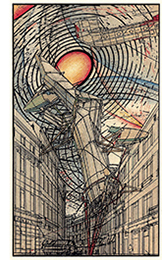
Event participants are Joseph Becker and Jennifer Dunlop Fletcher (San Francisco Museum of Modern Art); Maristella Casciato (The Getty Research Institute, Los Angeles); Steven Holl (Steven Holl Architects, New York); Peter Noever (Noever Design, Vienna); Leo Modrčin, Lovorka Prpić and Fedja Vukić (Faculty of Architecture, University of Zagreb); Andrija Rusan (Oris House of Architecture); Sven Sorić (graphic designer, Zagreb), and Aleksandra Wagner (Executor of the Estate of Lebbeus Woods).
The exhibition is co-organized by the University of Zagreb Faculty of Architecture, Oris House of Architecture, and the Estate of Lebbeus Woods, New York, with the Zagreb Museum of Arts and Crafts as the exhibition partner. The project also received support from the Ministry of Culture and Media of the Republic of Croatia.
The exhibition’s catalogue Lebbeus Woods: Zagreb Free Zone Revisited—edited by Leo Modrčin, Lovorka Prpić, and Aleksandra Wagner—can be purchased through the Oris House of Architecture.
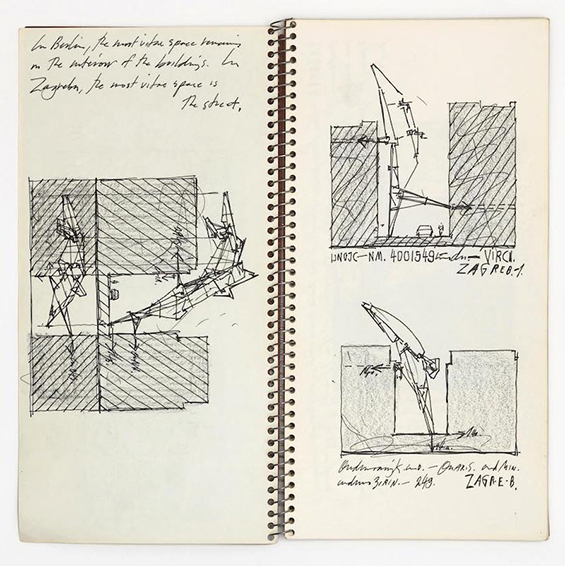
The exhibition is on view through April 24, 2021 at the Oris House of Architecture (Kralja Držislava 3) in Zagreb, Croatia.
Inset drawings by Lebbeus Woods, © Estate of Lebbeus Woods.
Ja Architecture Studio Receives P/A Award
POSTED ON: March 25, 2021
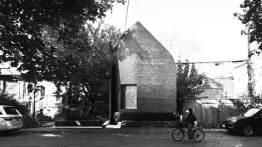
Ja Architecture Studio, a Toronto-based practice established by Visiting Professor Nima Javidi and Behnaz Assadi, has received a Progressive Architecture Award for Wardell, a recently completed residential addition on Wardell street in Toronto.
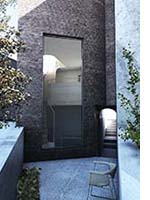 The project began as a side-yard extension to an existing two-story house on a triangular lot. Wardell “finds its identity through accentuating an anomalous urban condition,” according to the Studio. “Tucked into the wedge shaped lot, the two-storey side addition mediates between the string of two-storey mansard roof row houses, and the rear yard of the house on the corner…The curved wall creates a cleave between the existing house and the new addition and adds a visual cue that leads from the front walkout, through a passage under the recessed bridge that connects the two volumes to the sunken rear yard terrace and garden.”
The project began as a side-yard extension to an existing two-story house on a triangular lot. Wardell “finds its identity through accentuating an anomalous urban condition,” according to the Studio. “Tucked into the wedge shaped lot, the two-storey side addition mediates between the string of two-storey mansard roof row houses, and the rear yard of the house on the corner…The curved wall creates a cleave between the existing house and the new addition and adds a visual cue that leads from the front walkout, through a passage under the recessed bridge that connects the two volumes to the sunken rear yard terrace and garden.”
P/A jurors embraced this approach, noting that the project’s “steel-and-wood-framed addition allows the architects maximum flexibility in their willful form-making. At the same time, their decision to clad every exterior surface in brick allows the bold shape to play well with its more prosaic neighbors. The simple, straightforward design on a tricky site is both evocative and poetic, transforming an ordinary material typical of the neighborhood into something memorable both inside and out."
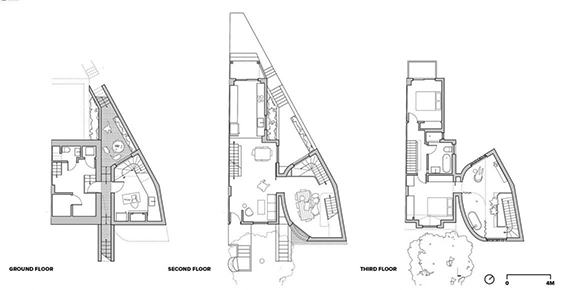
In December 2020, Wardell also received an Award of Excellence from Canadian Architect. A juror there described the project as “a little jewel in the middle of the city,” noting that “the designers could have just added to the existing house, but they created a separate object with a versatile space between…The sculptural shape is complemented by a very interesting tectonic approach that does something different with brick.”

Tags: Nima Javidi
What is a Monument?
POSTED ON: February 22, 2021
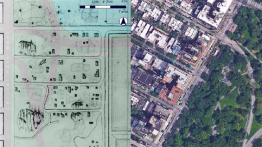
Still from Seneca Village: The Forgotten Community, by Laela Baker
For her fall 2020 History of Architecture course, Associate Professor Tamar Zinguer asked of her students: “How could a monument reflect the changing values of a dynamic society? Should a monument set in stone still stand if it reflects an intense amnesia and public forgetting? Does a monument need to be constructed, built and tangible, or could it be intangible, testifying to cultural heritage alone? Furthermore, could an artifact that is deemed to be a National Historic Landmark, for example, be relevant for a diverse society and reflect that all of history matters?”
The students, many of whom were residing outside of New York during the course, were prompted by Zinguer “to identify a site, or a building that interests you and…to research its history [and] present the contested ideas behind its appreciation or lack of it…” This research culminated in a 10-12 minute film created by each student as their final project for the course. Two of these films, made by students who remained in New York City, are presented here—Seneca Village: The Forgotten Community, by Laela Baker; and Deli: A Modern Monument of New York City, by Denise Cholula and Ru Jia.
Zinguer notes of Baker's film: “In 1825 African Americans began settling in Seneca Village, a five-acre plot of land from 82nd to 89th Street, between Central Park West and the road marking 7th Avenue before the Park was drawn. Some were upper middle-class citizens, who having become landowners, earned the right to vote and were politically involved. This community, which numbered close to 300 inhabitants by 1857 when their land was seized through eminent domain for the construction of Central Park, has been erased and largely ignored. In her film Laela Baker recounts the story of this impressive settlement, the site of which should be regarded as a historic civic monument.”
Cholula and Jia proposed for their monument a ubiquitous New York City institution—the deli. Tracing its origins from the 19th century Jewish delicatessen to its current multicultural incarnation as bodegas and corner stores, their film examines the deli’s design and its importance for neighborhoods and communities throughout the city.


